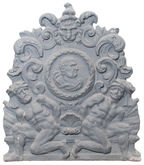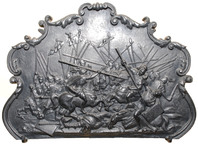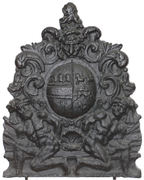-
452
Description: Circular wreathed medallion, bearing the right-facing head of a man in classical dress, carried by two naked, kneeling male figures seated on an elongated pedestal, between them a scallop shell; above the medallion a lion’s face surmounted by a flame; the medallion is surrounded by floral scrolls.
Notes: The wooden pattern would have had a circular aperture (the frame of which is just discernible) for the reception of the medallion; the same pattern was used to cast a fireback bearing the arms of George Worge, and the stamp of the profile was used on an accompanying fireplace side plate (no. 923).
- Decoration tags:
- baroque (shape)
- complex individual (edging)
- whole carved pattern
- pictorial
- humans
Manufactured: in the early- to mid-18th century probably at Robertsbridge Furnace, Salehurst in the Weald area of England.
Current location: Anne of Cleves House, Southover High Street, Lewes, East Sussex, England.
Museum number: LH000.998 (part of the Sussex Archaeological Society museum group)
Citation: Dawson, C., 1903, 'Sussex Iron Work and Pottery', Sussex Archaeological Collections, 46, pp. 1-54.
- Attached to series:
- Baroque series
-
560
Description: Quasi-arched rectangular shape with symmetrical double fillet rococo edging; high relief pictorial battle scene with mounted knights carrying lances and pennants.
Notes: The battle scene may have been inspired by more than one classical portayal of a battle in history; likely sources are 'The Defeat of the Pisans at the Tower of St Vicenzo' by Giorgio Vasari and 'Alexander the Great's crossing of the Granicus' by Charles Le Brun. An engraving by Daniel Kellerthaler (1574-1648) has a similar frame enclosing an unidentified cavalry conflict. Mitford collection, Petworth House.
Copies of this fireback are known.
- Decoration tags:
- baroque (shape)
- complex individual (edging)
- whole carved pattern
- pictorial
- humans
Manufactured: in the late-18th to early-19th century in England.
Current location: Petworth House, Petworth, West Sussex, England.
Museum number: NT/PET/M/54 (part of the National Trust museum group)
- Attached to series:
- Miscellaneous pattern firebacks
-
757
Description: Within a surround of symmetrical swirled foliage, an oval armorial shield carried by two naked, kneeling male figures seated on a broad pedestal, between them a scallop shell; above the shield a lion’s face surmounted by a crest of a lion’s head erased. The arms are of Worge impaling Collier.
Notes: George Worge (1705-65), of Starr’s Green, Battle, steward of the Battle Abbey estate, married Elizabeth (1707-66), daughter of John Collier, town clerk of Hastings, in 1727. The arms of Worge have been variously blazoned, but the memorial to George Worge in Battle church indicates these tinctures: gules, a fess cotised or, in chief three lion’s heads erased of the last; Collier - argent, on a chevron azure, between three unicorns courant couped gules, as many oak sprigs fructed proper. This deeply detailed fireback might have been cast in a closed mould; it had a circular aperture in the centre into which, in this instance, an armorial was placed; the same armorial is on a fireback, dated 1762, at Great Dixter, Northiam, Sussex, as is the lion crest (no. 1317).
Arms: Worge impaling Collier (George and Elizabeth Worge)
- Decoration tags:
- baroque (shape)
- complex individual (edging)
- whole carved pattern
- pictorial
- armorial
- humans
Manufactured: in the early- to mid-18th century probably at Robertsbridge Furnace, Salehurst in the Weald area of England.
Current location: Victoria & Albert Museum, Cromwell Road, Kensington & Chelsea, Greater London, England.
Museum number: 686.1899 (part of the Victoria & Albert Museum museum group)
- Attached to series:
- Baroque series
- Personal armorial firebacks
- Worge/Collier series


